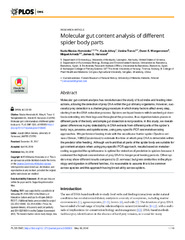Molecular gut content analysis of different spider body parts
Permanent lenke
https://hdl.handle.net/10037/13950Dato
2018-05-30Type
Journal articleTidsskriftartikkel
Peer reviewed
Forfatter
Macías-Hernández, Nuria; Athey, Kacie; Tonzo, Vanina; Wangensteen Fuentes, Owen Simon; Arnedo, Miquel A.; Harwood, James D.Sammendrag
Molecular gut-content analysis has revolutionized the study of food webs and feeding interactions, allowing the detection of prey DNA within the gut of many organisms. However, successful prey detection is a challenging procedure in which many factors affect every step, starting from the DNA extraction process. Spiders are liquid feeders with branched gut diverticula extending into their legs and throughout the prosoma, thus digestion takes places in different parts of the body and simple gut dissection is not possible. In this study, we investigated differences in prey detectability in DNA extracts from different parts of the spider´s body: legs, prosoma and opisthosoma, using prey-specific PCR and metabarcoding approaches. We performed feeding trials with the woodlouse hunter spider Dysdera verneaui Simon, 1883 (Dysderidae) to estimate the time at which prey DNA is detectable within the predator after feeding. Although we found that all parts of the spider body are suitable for gut-content analysis when using prey-specific PCR approach, results based on metabarcoding suggested the opisthosoma is optimal for detection of predation in spiders because it contained the highest concentration of prey DNA for longer post feeding periods. Other spiders may show different results compared to D. verneaui, but given similarities in the physiology and digestion in different families, it is reasonable to assume this to be common across species and this approach having broad utility across spiders.
Beskrivelse
Source at: http://doi.org/10.1371/journal.pone.0196589


 English
English norsk
norsk